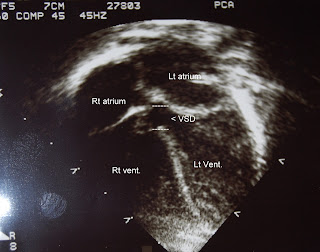So here's a little lesson on the heart and a VSD. Your heart has 4 chambers, the 2 top ones, the atriums and the 2 lower ones, the ventricles. There is a "wall" that separates the ventricles from one another called, the ventricular septum, this is were her hole is. The lower half of the septum is very muscular and if a hole occurs here it usually closes on its own or a catheterization procedure can take care of it. Unfortunately Jordan's defect is in the upper membranous portion of the septum. These can close on their own when small but Jordan's, being 7mm, is considered on the large side, this means big time open heart surgery is in the future. The problem this hole causes is the oxygen rich blood from the left ventricle gets sucked into the right ventricle instead of getting pumped to the body. The oxygen rich blood then mixes with the oxygen poor blood of the right ventricle and gets sent to the lungs, again. This causes an over abundance of blood to go to the lungs which causes rapid breathing, increased heart rate and a whole slew of other problems. Surgery needs to be performed before certain symptoms become too prevalent in order to protect the lungs and heart from permanent damage.
 |
| A picture of Jordan's VSD |
No comments:
Post a Comment